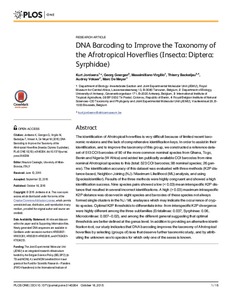| dc.contributor.author | Jordaens, K. |
| dc.contributor.author | Goergen, Georg E. |
| dc.contributor.author | Virgilio, M. |
| dc.contributor.author | Backeljau, B. |
| dc.contributor.author | Vokaer, A. |
| dc.contributor.author | Meyer, M. de |
| dc.date.accessioned | 2019-12-04T10:58:12Z |
| dc.date.available | 2019-12-04T10:58:12Z |
| dc.date.issued | 2015-10-16 |
| dc.identifier.citation | Jordaens, K., Goergen, G., Virgilio, M., Backeljau, T., Vokaer, A. & De Meyer, M. (2015). DNA Barcoding to Improve the Taxonomy of the Afrotropical Hoverflies (Insecta: Diptera: Syrphidae). PloS one, 10(10), e0140264. |
| dc.identifier.issn | 1932-6203 |
| dc.identifier.uri | https://hdl.handle.net/20.500.12478/940 |
| dc.description.abstract | The identification of Afrotropical hoverflies is very difficult because of limited recent taxonomic revisions and the lack of comprehensive identification keys. In order to assist in their identification, and to improve the taxonomy of this group, we constructed a reference dataset of 513 COI barcodes of 90 of the more common nominal species from Ghana, Togo, Benin and Nigeria (W Africa) and added ten publically available COI barcodes from nine nominal Afrotropical species to this (total: 523 COI barcodes; 98 nominal species; 26 genera). The identification accuracy of this dataset was evaluated with three methods (K2P distance-based, Neighbor-Joining (NJ) / Maximum Likelihood (ML) analysis, and using SpeciesIdentifier). Results of the three methods were highly congruent and showed a high identification success. Nine species pairs showed a low (< 0.03) mean interspecific K2P distance that resulted in several incorrect identifications. A high (> 0.03) maximum intraspecific K2P distance was observed in eight species and barcodes of these species not always formed single clusters in the NJ / ML analayses which may indicate the occurrence of cryptic species. Optimal K2P thresholds to differentiate intra- from interspecific K2P divergence were highly different among the three subfamilies (Eristalinae: 0.037, Syrphinae: 0.06, Microdontinae: 0.007–0.02), and among the different general suggesting that optimal thresholds are better defined at the genus level. In addition to providing an alternative identification tool, our study indicates that DNA barcoding improves the taxonomy of Afrotropical hoverflies by selecting (groups of) taxa that deserve further taxonomic study, and by attributing the unknown sex to species for which only one of the sexes is known. |
| dc.format.extent | 1-15 |
| dc.language.iso | en |
| dc.subject | Syrphidae |
| dc.subject | Flowering Plants |
| dc.subject | Pest Control |
| dc.subject | Dna |
| dc.title | DNA Barcoding to Improve the Taxonomy of the Afrotropical Hoverflies (Insecta: Diptera: Syrphidae) |
| dc.type | Journal Article |
| dc.description.version | Peer Review |
| cg.contributor.affiliation | Royal Museum for Central Africa, Belgium |
| cg.contributor.affiliation | University of Antwerp |
| cg.contributor.affiliation | International Institute of Tropical Agriculture |
| cg.contributor.affiliation | Royal Belgian Institute of Natural Sciences |
| cg.coverage.region | Africa |
| cg.coverage.region | West Africa |
| cg.coverage.country | Benin |
| cg.coverage.country | Ghana |
| cg.coverage.country | Nigeria |
| cg.coverage.country | Togo |
| cg.isijournal | ISI Journal |
| cg.authorship.types | CGIAR and advanced research institute |
| cg.iitasubject | Genetic Improvement |
| cg.iitasubject | Pests Of Plants |
| cg.journal | PLOS ONE |
| cg.howpublished | Formally Published |
| cg.accessibilitystatus | Open Access |
| local.dspaceid | 76442 |
| cg.identifier.doi | https://dx.doi.org/ 10.1371/journal.pone.0140264 |

